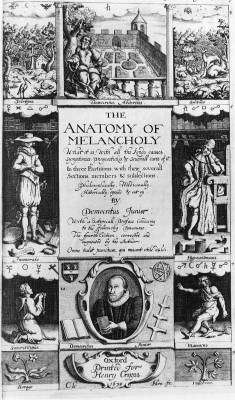Robert Burton (scholar)
| Robert Burton | |
|---|---|
 | |
| Born |
8 February 1577 Lindley, Leicestershire, England |
| Died |
25 January 1640 (aged 62) Oxford, Oxfordshire, England |
| Alma mater | Brasenose College, Oxford |
| Church | Church of England |
| Writings | The Anatomy of Melancholy |
Offices held | Vicar, rector |
Robert Burton (8 February 1577 – 25 January 1640) was an English scholar at Oxford University, best known for the classic The Anatomy of Melancholy. He was also the incumbent of St Thomas the Martyr, Oxford, and of Seagrave in Leicestershire.
Life
Born at Lindley, Leicestershire, Robert Burton was the son of Ralph and Dorothy Burton and the brother of William Burton the antiquary. Burton spent most of his life at Oxford, first as a pupil at Brasenose College, and then as a student (the equivalent of a fellow at other Oxford and Cambridge colleges) of Christ Church. He studied a large number of diverse subjects, many of which informed the study of melancholia, for which he is chiefly famous. He was appointed vicar of St Thomas' Church in Oxford in 1616, and in 1630 he was also made the rector of Seagrave in Leicestershire.
Burton was a mathematician and dabbled in astrology. When not depressed he was an amusing companion, "very merry, facete, and juvenile", and a person of "great honesty, plain dealing, and charity". Merry, indeed, Burton had favourite sources for laughter. In 1728 Bishop Kennet wrote that:
I have heard that nothing could make him laugh, but going down to the Bridge-foot in Oxford and hearing the Barge-men scold and storm and swear at one another, at which he would set his Hands to his Sides, and laugh most profusely.
There was a rumour that Burton hanged himself in his chambers at Christ Church,[1] supposedly so that his death would match his prediction.
Burton was buried at Christ Church Cathedral in Oxford.
Work

Burton's Melancholy focuses sharply on the self; unlike Bacon, Burton assumes that knowledge of psychology, not natural science, is humankind's greatest need. His enormous treatise is considered "delightful" by critics; it examines in encyclopaedic detail the ubiquitous Jacobean malady, melancholy, supposedly caused by an excess of "black bile", according to the humour theory fashionable at the time.[2]
Melancholy was responsible, according to Burton and others, for the wild passions and despairs of lovers, the agonies and ecstasies of religious devotees, the frenzies of madmen, and the studious abstraction exemplified by scholars such as Shakespeare or Milton.
He wrote The Anatomy of Melancholy largely to write himself out of being a lifelong sufferer from depression. As he described his condition in the preface "Democritus Junior to the Reader,"
for I had gravidum cor, foetum caput [a heavy heart, hatchling in my head], a kind of imposthume in my head, which I was very desirous to be unladen of.
Therefore, the treatise itself was intended as treatment. Again, from the preface:
I write of melancholy, by being busy to avoid melancholy. There is no greater cause of melancholy than idleness, no better cure than business.
However, this sentence may also be interpreted ironically, as Burton is citing a well-known adage of the time. Indeed, the entire preface is quite satirical in nature—at one point Burton pretends to warn melancholics to avoid his book for fear of exacerbating their symptoms:
Yet one caution let me give by the way to my present or future reader, who is actually melancholy, that he read not the symptoms or prognostics in the following tract, lest by applying that which he reads to himself, aggravating, appropriating things generally spoken to his own person (as melancholy men for the most part do), he trouble or hurt himself, and get in conclusion more harm than good.
The parenthetical aside is meant to be tongue-in-cheek.

The work, published under the pseudonym Democritus Junior in 1621, was quite popular. In the words of Thomas Warton:
the author's variety of learning, his quotations from rare and curious books, his pedantry sparkling with rude wit and shapeless elegance ... have rendered it a repertory of amusement and information.
Many later writers were deeply influenced by the book's odd mix of pan-scholarship, humour, linguistic skill, and creative (if highly approximate) insights. This influence was so strong that later writers sometimes drew from the work without acknowledgment (such accusations were levelled at Laurence Sterne's book Tristram Shandy).
Samuel Johnson considered it one of his favourite books, being "the only book that ever took him out of bed two hours sooner than he wished to rise".[3] The book has continued as a favourite among many twentieth and twenty-first-century authors, such as Anthony Burgess (who said "Most modern books weary me, but Burton never does"), William H. Gass (who wrote the introduction to the 2001 omnibus edition), and Llewelyn Powys (who dubbed it "the greatest work of prose of the greatest period of English prose-writing"). Apart from The Anatomy of Melancholy Burton's only other published work is Philosophaster, a satirical Latin comedy.
Bibliography
- The Anatomy of Melancholy, New York Review of Books, 2001. One-volume reprint of 1932 three-volume Everyman pocket edition, with a new introduction by William H. Gass
- The Anatomy of Melancholy, Clarendon Press/Oxford University Press, 1989–2001. A scholarly edition in six volumes with commentary, edited by Thomas C. Faulkner, Nicolas K. Kiessling, and Rhonda L. Blair, introduced and commented by J. B. Bamborough.
Notes
- ↑ John Aubrey (1975) Brief Lives ISBN 0-85115-206-6; p.52: "Mr Robert Hooke of Gresham college told me that he lay in the chamber in Christ Church that was Mr Burton's, of whom 'tis whispered that notwithstanding all his astrology and his book of melancholy, he ended his days in that chamber by hanging himself."
- ↑ Abrams, Howard Meyers, ed. (1999) The Norton Anthology of English Literature; Vol. 1; seventh edition; New York: W. W. Norton & Co Inc. ISBN 978-0-393-97487-4
- ↑ Boswell, Life of Johnson.
References

- Heusser, Martin. The Gilded Pill: The Reader-Writer Relationship in Robert Burton’s Anatomy of Melancholy. Tübingen: Stauffenburg, 1987.
External links
| Wikimedia Commons has media related to Robert Burton (scholar). |
| Wikiquote has quotations related to: Robert Burton |
| Wikisource has the text of the 1911 Encyclopædia Britannica article Burton, Robert. |
- Review and quotes at complete review
- Entry at the Columbia Encyclopedia
- The BBC's "In Our Time" discusses The Anatomy of Melancholy.
- Online texts

- Works by Robert Burton at Project Gutenberg
- Works by or about Robert Burton at Internet Archive
- Works by Robert Burton at LibriVox (public domain audiobooks)
